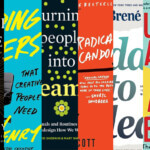A massive amount of contextual information is lost when we aren’t working together in person. Whether we are conscious of it or not, it’s the nonverbal communication and unstructured discussion that make up a huge part of how we work collaboratively. Naturally, teams accustomed to working in close proximity have been set adrift by a sudden shift in work style.
There are ways to make up for this gap in visual context to make collaboration efficient even from a distance. Working together without being together requires embracing mediums that limit ambiguity or vagueness – often by letting the work speak, or be seen, for itself.
The Soft Conditions of Collaboration
What has allowed “traditional” collaboration to work, regardless of the venue, is that so long as collaborators are in the same (physical) space there are a wide range of options to effectively communicate ideas.
The more communication tools or options at your disposal, the higher the probability of precision, clarity and message decoding. If you’re struggling to explain an abstract concept to a colleague, you can grab a pen, scribble out a rudimentary diagram, and create alignment in real time, with a lexicon of quick nonverbal cues to indicate where there’s confusion. When reviewing work, it’s simple to point something out with a finger, or by momentarily commandeering control of a mouse, marker or a meeting. If you need a second, third or fourth opinion, or expert subject knowledge, it can be as easy as calling someone over from across a room or hallway. And we can’t forget the whiteboard – longtime utilitarian champion of collaborators everywhere, for good reason.
This way of collaborating works because it affords everyone involved the benefit of clarity and ease of participation through their medium of individual preference. The presenter can choose the medium they are most comfortable and effective communicating in. It’s not only the medium of presentation, but the conditions, timing, environment, materials, and any other mechanisms a communicator can control to be more effective.
We can call these the “soft” conditions of collaboration – they result from tangible or logistical factors and are essential to facilitating harmonious cooperation and creation.
To re-enable creative and collaborative flow with a dispersed team, these conditions must first be re-established.
The Brain as Image Processor
Science has repeatedly proven that visual explanations are highly effective tools for learning and ultimately result in increased understanding with better recall. This is because “words are abstract and rather difficult for the brain to retain, whereas visuals are concrete and, as such, more easily remembered,” writes Dr. Haig Kouyoumdjian for Psychology Today.
And that’s even before you factor in processing words that are not coming directly from their source but through the prism of a video call, the constraints of an email client or static document (without intonation), and so forth. The brain is, first and foremost, an image processor – the part devoted to processing words is minuscule by comparison. (This is why memory experts suggest visualization techniques for memorization – like the “memory palace” trick.)
Visuals allow for greater precision while circumventing the abstraction and arbitrary limitations of other mediums. Visual representations are also adaptable and versatile, providing numerous possibilities for conveying complex information.
Back to the Drawing Board – Figuratively and Literally
To enable the remote workspace for collaboration, the “soft” conveniences of being together must be re-established in some way. And so, if clarity and flexibility are what facilitate fluid collaboration, a visual-first approach should direct work that is done together while apart.
Perhaps this is why project management tools come and go. The project management tool is not built for intuitive visual clarity, but to track and manage “words”, “tasks” and maybe even “dates.”
The new collaboration has to be highly visual. What is lost by not being in the same room together can be made up by organizing information and ideas in specific, illustrative ways that are interactive and easily manipulated?
What does this mean, exactly?
Workflows are supported by solutions where a central virtual workspace puts visual context at the heart of everything.
Collaboration Tools That are Visual-First
The tools that most effectively support the new, visually-driven collaboration are also:
- Contextual: Feedback and conversation must drive clarity. Email, Slack or even a phone call inherently lack context and reference. The ability to screen share via the likes of Zoom or Hangouts is an important feature that we are increasingly relying on. ReviewStudio delivers a great way to provide feedback in context not only in a synchronized manner, but asynchronously as well.
- Flexible: Collaboration tools should offer users a range of options or tools to choose from in order to convey an idea or information in this visual manner. ReviewStudio is a good example, with a full suite of markup tools giving reviewers flexibility when appending feedback directly to its context, from freehand drawing to sticky notes and text selection on a range of media.
- Interactive: Teams need to be able to review and annotate work in conjunction with their collaborators, ideally in real time. Synchronous and threaded conversations should allow users to discuss aspects of the work being reviewed with visual context, and even add further visuals directly into the conversation as attachments.
- Enabling Accountability: Having a record of conversation, tasks, approvals, or general context is essential in a remote work environment – for reference, accessibility and smoother project management.
These principles work together to simulate the free-flowing, instinctive and uninterrupted collaborative environment that teams have long enjoyed – perhaps even enhancing it.

Remaining Inclusive
Many organizations have policies in place as equal opportunity employers. And even though it can be challenging in the best of times, this rapid transformation doesn’t have a playbook. To round out this idea on visual collaboration, organizational empathy is essential, especially to those with specific accessibility needs. Taking stock of leadership practice is one key exercise to start with.
Visual Collaboration Tools are the Way Forward
This past year has proven a need for these sophisticated tools, and a more intentional approach to visual collaboration in general what with the rapid shift to remote work. People are catching on: Google Hangouts now offers virtual whiteboarding directly in Hangouts. Zoom has a range of annotation tools that can be used over a call. Figma is the very definition of visual collaboration for all things graphic design. MURAL’s shared workspace is a whiteboard on steroids. And of course, ReviewStudio is built for visual collaboration for your creative workflows.
Beyond Visual Aids
Adapting office-bound workflows to a remote-first or hybrid context inevitably adds an additional layer of complexity. Fortunately we live in an era where technology, when used well, can help to navigate around daunting logistical obstacles and even improve processes.
For collaboration, that means choosing the tools that give the most freedom to communicate exactly what you mean in a variety of ways, with visual precision and clarity. We are well beyond the era of the bonus “visual aid” – visuals are now the vehicle of effective collaboration.







